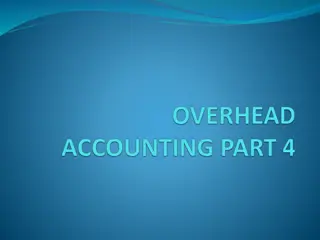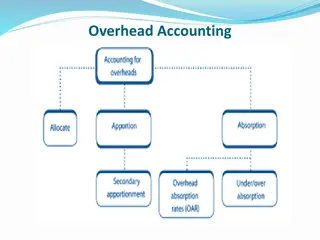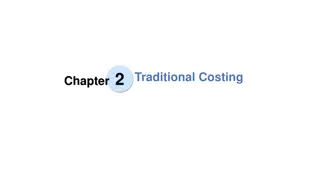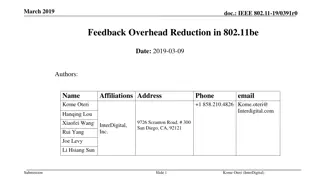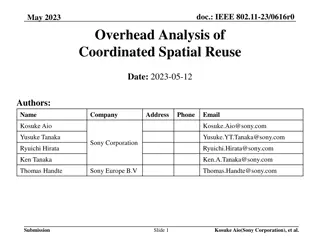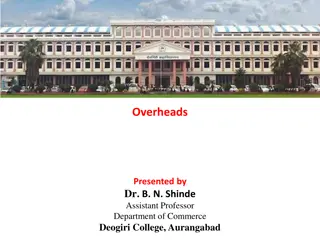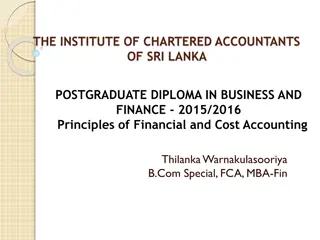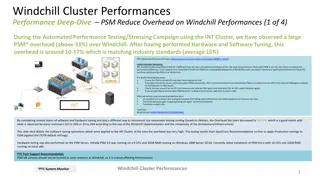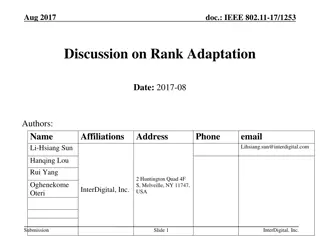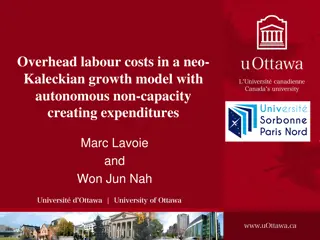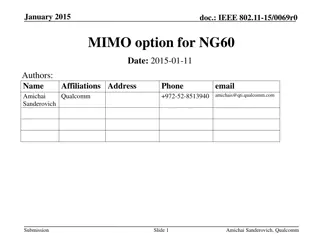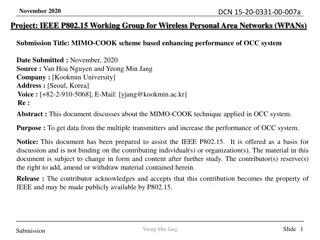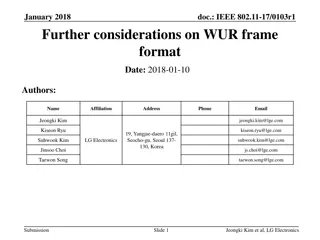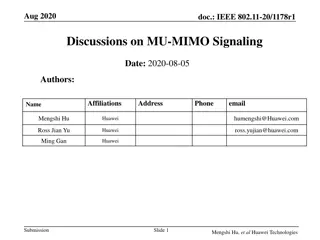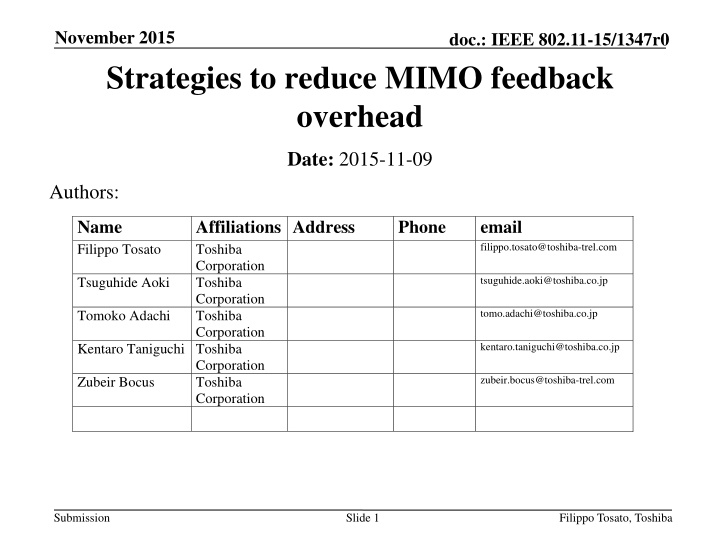
Reduce MIMO Feedback Overhead Strategies
Explore strategies to minimize MIMO feedback overhead in IEEE 802.11 protocols, focusing on compression techniques for efficient spatial data representation. Learn about reducing feedback bits using various coding methods for improved transmission efficiency.
Download Presentation

Please find below an Image/Link to download the presentation.
The content on the website is provided AS IS for your information and personal use only. It may not be sold, licensed, or shared on other websites without obtaining consent from the author. If you encounter any issues during the download, it is possible that the publisher has removed the file from their server.
You are allowed to download the files provided on this website for personal or commercial use, subject to the condition that they are used lawfully. All files are the property of their respective owners.
The content on the website is provided AS IS for your information and personal use only. It may not be sold, licensed, or shared on other websites without obtaining consent from the author.
E N D
Presentation Transcript
November 2015 Strategies to reduce MIMO feedback overhead doc.: IEEE 802.11-15/1347r0 Date: 2015-11-09 Authors: Name Filippo Tosato Affiliations Address Toshiba Corporation Toshiba Corporation Toshiba Corporation Phone email filippo.tosato@toshiba-trel.com tsuguhide.aoki@toshiba.co.jp Tsuguhide Aoki tomo.adachi@toshiba.co.jp Tomoko Adachi kentaro.taniguchi@toshiba.co.jp Kentaro Taniguchi Toshiba Corporation Toshiba Corporation zubeir.bocus@toshiba-trel.com Zubeir Bocus Submission Slide 1 Filippo Tosato, Toshiba
November 2015 doc.: IEEE 802.11-15/1347r0 Abstract In this presentation we discuss strategies to reduce the MIMO feedback overhead. In particular, we focus on a compression technique that operates in the spatial direction by compressing multiple eigenmodes with fewer coefficients than the Givens decomposition. Submission Slide 2 Filippo Tosato, Toshiba
November 2015 doc.: IEEE 802.11-15/1347r0 Feedback overhead reduction in 11ax In frequency: 11ac already adopted tone grouping such that feedback may be provided for every 2nd or 4th subcarrier In time: high correlation of feedback coefficients in successive reports can be exploited by using some source coding techniques for compression (e.g., differential feedback) In space: note that by going from 1 to 2 STA s antennas the feedback bits in 11ac increase by 50%, going from 3 to 6 antennas the increase is 150%. In this presentation we show how multiple eigenmodes can be compressed by representing their vector space up to a rotation matrix Submission Slide 3 Filippo Tosato, Toshiba
November 2015 doc.: IEEE 802.11-15/1347r0 MIMO compressed feedback in 11ac STA ? measures the channel for subcarrier? from the LTFs of the NDP and decomposes the channel matrix into an orthonormal column matrix, ??,?, of size ?? ??, and a real diagonal matrix ??,? from the SVD of the effective channel ????,?,?= ??,???,???,? ??,?is represented in compressed form by Givens rotations min{??,?? 1} ? ?? ?(???) ??? ?? ??(1? 1,????,?, ,????? 1,?) ? = ??? ?=?+1 ?=1 Submission Slide 4 Filippo Tosato, Toshiba
November 2015 doc.: IEEE 802.11-15/1347r0 MIMO compressed feedback in 11ac Givens representation of ? consists of ?? [0,2?) and ?? ??= ??(2?? ?? 1) NOTE: the number of real dimensions of ? is ??(2?? ??) but the feedback does not need to capture the absolute phase of the columns of ? The angles are uniformly quantised with the same resolution (2 more bits are needed for ? angles than ?) 2 angles {?} in 2 angles {?} in [0,?/2] with Submission Slide 5 Filippo Tosato, Toshiba
November 2015 doc.: IEEE 802.11-15/1347r0 SNR reporting in 11ac SNR is reported for each spatial stream ? 2 ????,?,?=[??,?]?,? ?0 Average SNR across the feedback tones, 8 bit uniform quantisation between -10dB and 53.75dB Delta SNR for each feedback tone, 4 bit uniform quantisation between - 8dB and 7dB Submission Slide 6 Filippo Tosato, Toshiba
November 2015 doc.: IEEE 802.11-15/1347r0 Modified representation of ? A cosine-sine decomposition allows to represent the ? matrix with fewer quantised values 11ac compressed feedback START Input: ? START Input: ? Find CS Find Givens decomposition of ? decomposition of ? The feedback signals a linear combination of the 11ac eigenmodes ? Quantisation STOP Output quantised feedback Submission Slide 7 Filippo Tosato, Toshiba
November 2015 doc.: IEEE 802.11-15/1347r0 Modified representation of ? An equivalent representation to Givens rotations can be achieved by a 2-step decomposition ? = ???? Step 1: Grassmannian (GR) representation of ?, through a CS decomposition, which yields ? Step 2: Givens decomposition of ??? The combined 2-step decomposition requires the same number and type of coefficients as in the Givens decomposition The GR representation alone allows to save bits in the representation of multiple eigenmodes with small loss in beamforming gain Submission Slide 8 Filippo Tosato, Toshiba
November 2015 doc.: IEEE 802.11-15/1347r0 Proposal to add a new representation of the beamforming feedback matrix in 11ax The beamformee feeds back an ?? ?? orthonormal matrix ? = ??? with ?? unitary matrix of size ?? ?? ?? is known to the beamformee but unknown to the beamformer ? is represented in compressed form by a matrix ? as follows ?1cos ? ?1 ?21sin ? ?1 ?1sin ? ?21 ?21cos ? ?21 with the matrices obtained by an SVD ? ?, ?? ?? 2 ? = ? ??>?? , ?+ ?22 ?22 ? 2 ? 0 ?1 ? ? = ( ?21 ?22) Submission Slide 9 Filippo Tosato, Toshiba
November 2015 doc.: IEEE 802.11-15/1347r0 Proposal to add a new representation of the beamforming feedback matrix in 11ax The matrix ? = [?]??= ???????? is of size max( ) ?? min ??,?? ?? and its representation consists of ?? angles, {?}, in [0,2?) and ?? with ??= 2(?? ??)?? It can be shown that |???| ? 2 Note that ?? ??, and ??= ?? only for ??= 1 For ??= 1 the representation is equivalent to that of 11ac The parameters {?} and {?} are uniformly quantised in the same way as {?} and {?}, respectively ??,?? 2 2 magnitudes, {?}, in [0,?/2] Submission Slide 10 Filippo Tosato, Toshiba
November 2015 doc.: IEEE 802.11-15/1347r0 Proposed SNR reporting in 11ax Average SNR is reported across spatial streams ?? 1 ?? 2 [??,?]?,? ?=1 ?0 ????,?= This average per-stream SNR is reported in the same way as 11ac with 8 bit average SNR across tones and 4 bits delta SNR Submission Slide 11 Filippo Tosato, Toshiba
November 2015 doc.: IEEE 802.11-15/1347r0 How the beamformee computes ? Beamformee computes CS decomposition (thin version) of ? (same cost as SVD of size ?? ??) (? ? ) ?1 0 0 0 ?21 ?22 0 ? is given by ? = (?21 cos? sin? sin? cos? 0 ?22)? 0 0 ? ? ?1 0 0 0 = ?21 ?22 ? ?1 0 Submission Slide 12 Filippo Tosato, Toshiba
November 2015 doc.: IEEE 802.11-15/1347r0 Overhead comparison 11ac Proposed SNR report (bits) Size of ? (?? ??) Number of angles per tone (??) SNR report (bits) Number of angles per tone (??) Overhead reduction (MU high-res, ????=52) (%) 0 51.8 0 35.8 69 0 22.8 51.9 77.5 2x1 2x2 3x1 3x2 3x3 4x1 4x2 4x3 4x4 2 2 4 6 6 6 8+4???? 2(8+4????) 8+4???? 2(8+4????) 3(8+4????) 8+4???? 2(8+4????) 3(8+4????) 4(8+4????) 2 - 4 4 - 6 8 6 - 8+4???? 8+4???? 8+4???? 8+4???? 8+4???? 8+4???? 8+4???? 8+4???? 8+4???? 10 12 12 Submission Slide 13 Filippo Tosato, Toshiba
November 2015 doc.: IEEE 802.11-15/1347r0 Further overhead reduction The proposal can be combined with tone grouping and other techniques to reduce the overhead further in the time direction In particular by exploiting the correlation of the angular coefficients between consecutive reports in the time direction The same differential feedback techniques can be applied to the Givens coefficients as well as the proposed transformation coefficients. Submission Slide 14 Filippo Tosato, Toshiba
November 2015 doc.: IEEE 802.11-15/1347r0 4 TX, 2 RX antennas, 3 STAs, 1 stream/STA Feedback rank is ??= 1 (1 eigenmode), no overhead reduction No need for reporting 2 eigenmodes, performance is the same Submission Slide 15 Filippo Tosato, Toshiba
November 2015 doc.: IEEE 802.11-15/1347r0 4 TX, 2 RX antennas, 2 STAs, 2 streams/STA Feedback rank is ??= 2, overhead reduction in compressed feedback matrix is 20% For the proposed scheme reporting average SNR across spatial streams shows similar performance as per-stream SNR, overhead reduction in SNR reporting is 50% 52 feedback tones Feedback overhead V (bits/report) 4160 3328 Feedback overhead SNR (bits/report) 432 216 Overhead reduction (%) - 22.8% 11ac proposed Submission Slide 16 Filippo Tosato, Toshiba
November 2015 doc.: IEEE 802.11-15/1347r0 Submission Slide 17 Filippo Tosato, Toshiba
November 2015 doc.: IEEE 802.11-15/1347r0 Submission Slide 18 Filippo Tosato, Toshiba
November 2015 doc.: IEEE 802.11-15/1347r0 Sensitivity to channel aging We can trade off the reduced overhead for increased feedback granularity. Submission Slide 19 Filippo Tosato, Toshiba
November 2015 doc.: IEEE 802.11-15/1347r0 Performance in closed-loop SU-MIMO 3 TX, 2 RX antennas, 2 streams Feedback overhead V (bits/report) 2496 1664 Feedback overhead SNR (bits/report) 432 216 Overhead reduction (%) - 35.8% 11ac proposed 4 TX, 3 RX antennas, 3 streams Feedback overhead V (bits/report) 4992 2496 Feedback overhead SNR (bits/report) 648 216 Overhead reduction (%) - 51.9% 11ac proposed Submission Slide 20 Filippo Tosato, Toshiba
November 2015 doc.: IEEE 802.11-15/1347r0 There is some beamforming gain loss with GR feedback, which disappears when comparing at the same overhead with channel aging Submission Slide 21 Filippo Tosato, Toshiba
November 2015 doc.: IEEE 802.11-15/1347r0 Summary MIMO Feedback overhead can be reduced by adopting different compression strategies in frequency (e.g., tone grouping), in time (e.g., differential feedback) and in space (spatial compression of multiple eigenmodes) We showed how the representation of multiple eigenmodes can be modified to achieve a higher level of compression Performance evaluation shows that the beamforming gain loss is minimal especially for MU-MIMO, whilst the overhead saving is substantial (typically between ~20% and 50%) Submission Slide 22 Filippo Tosato, Toshiba

